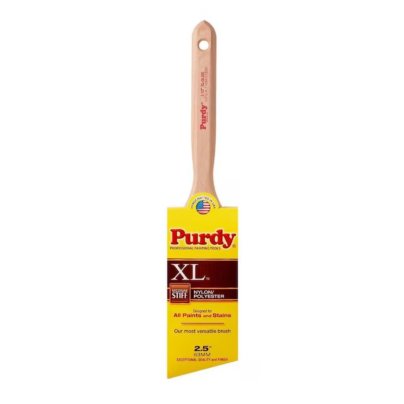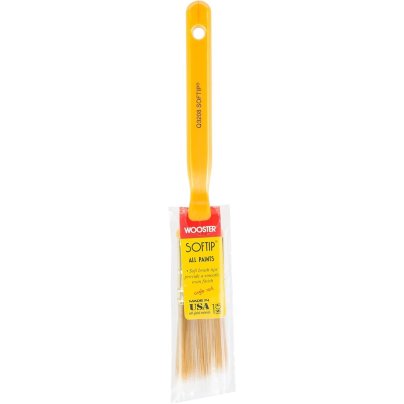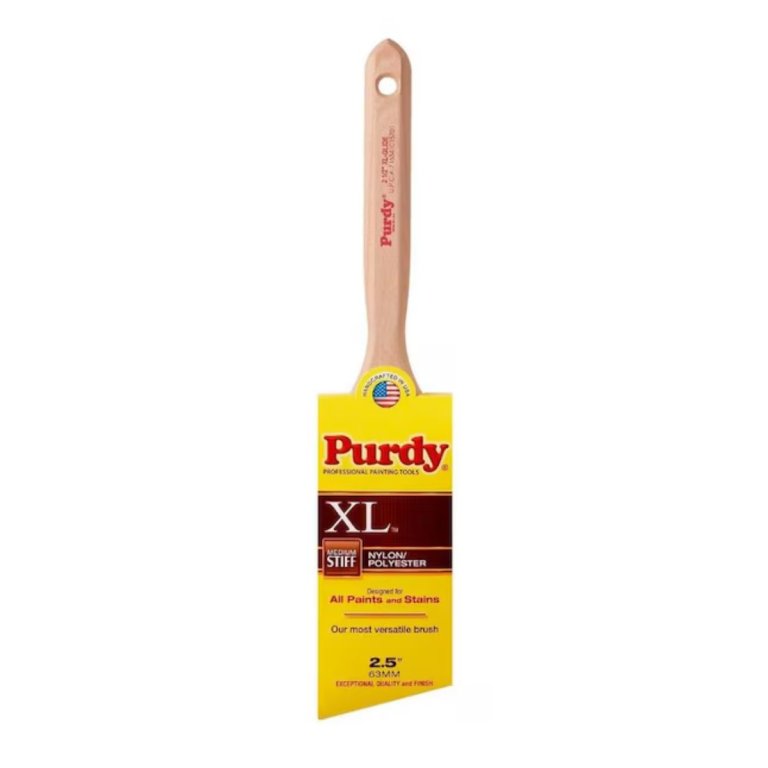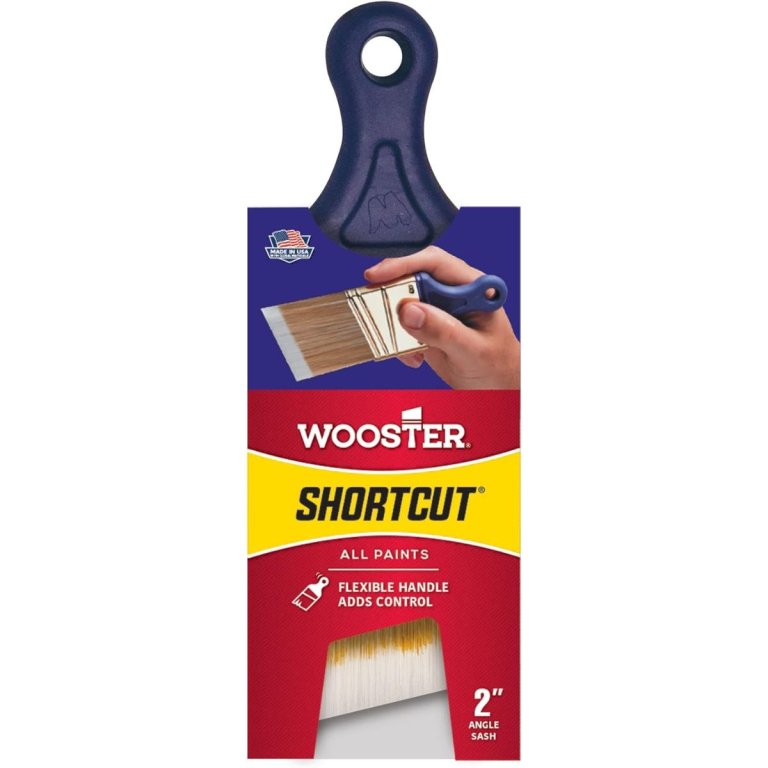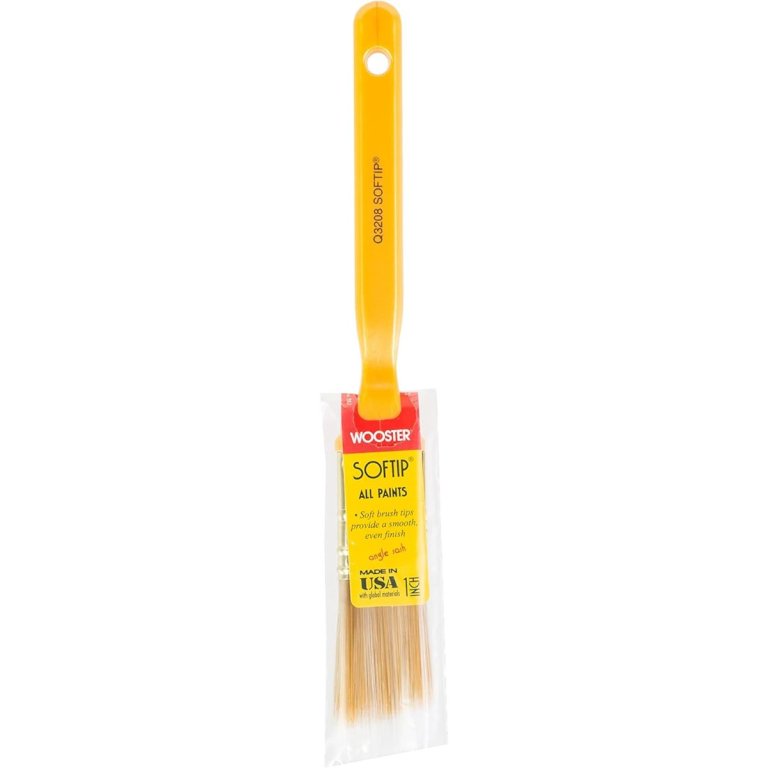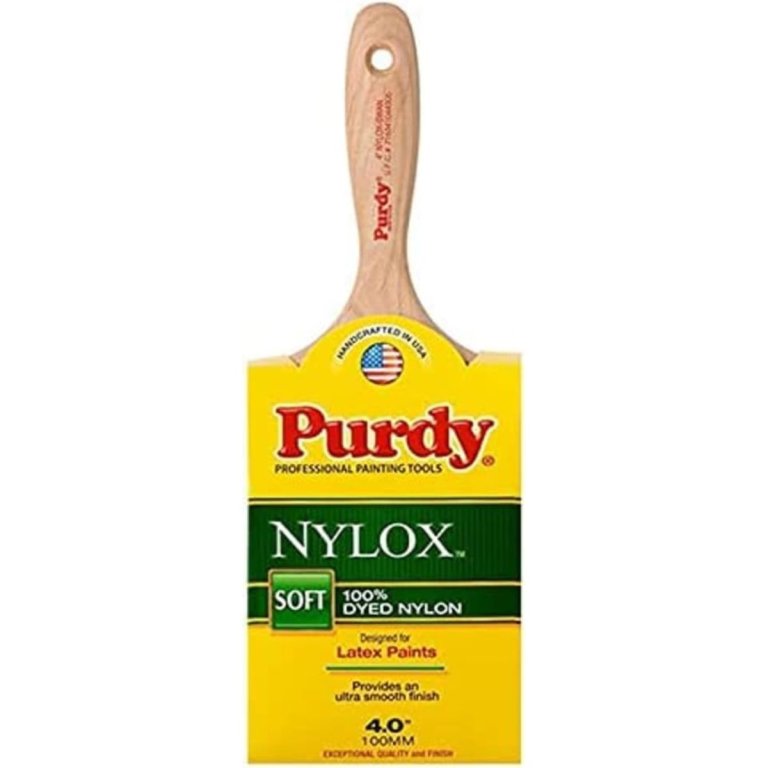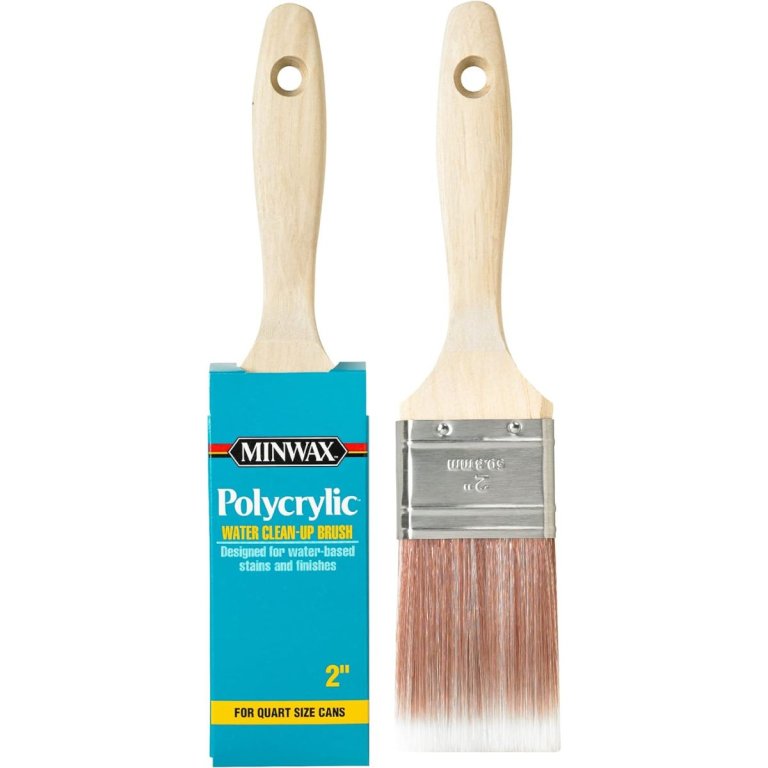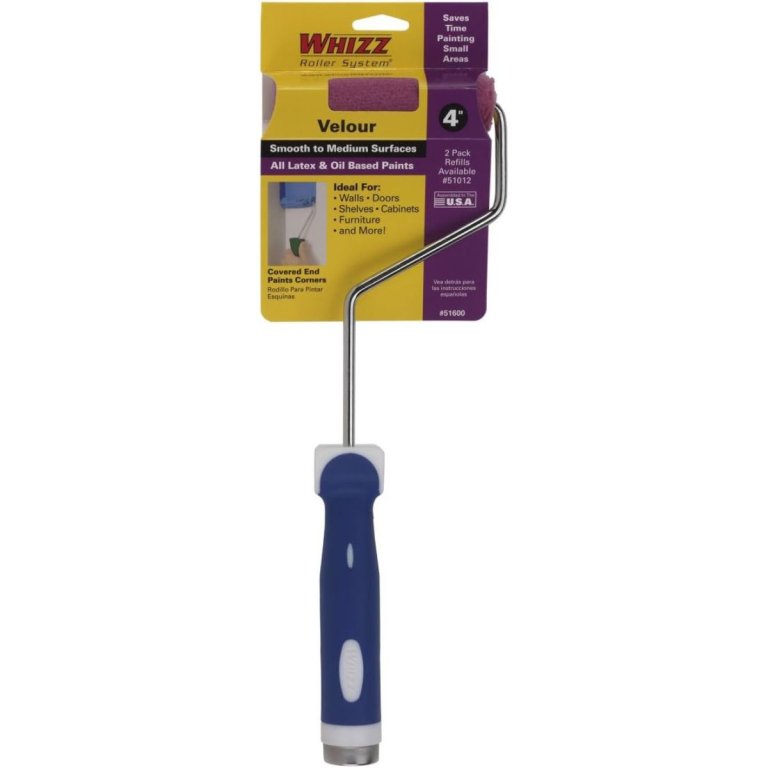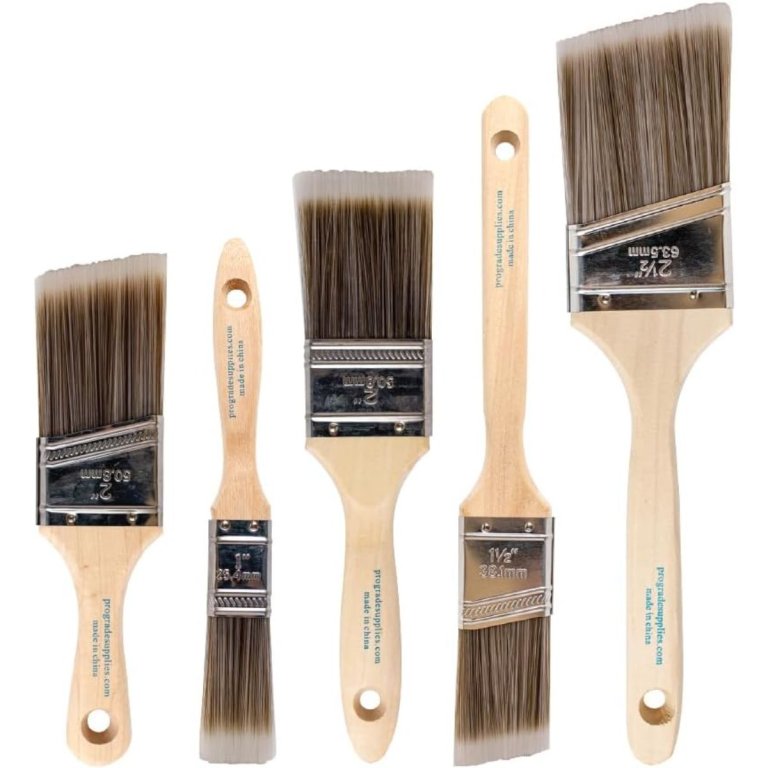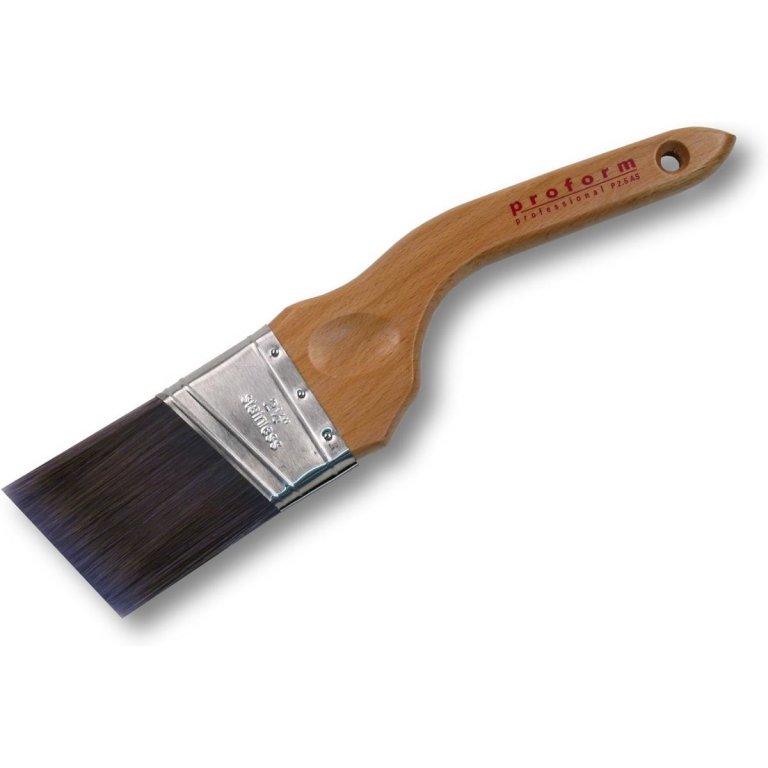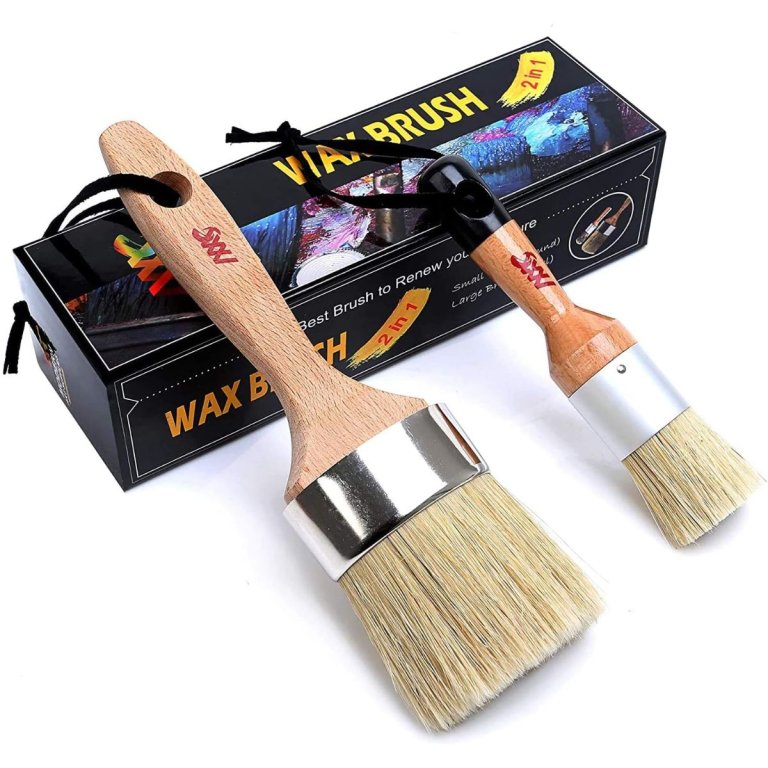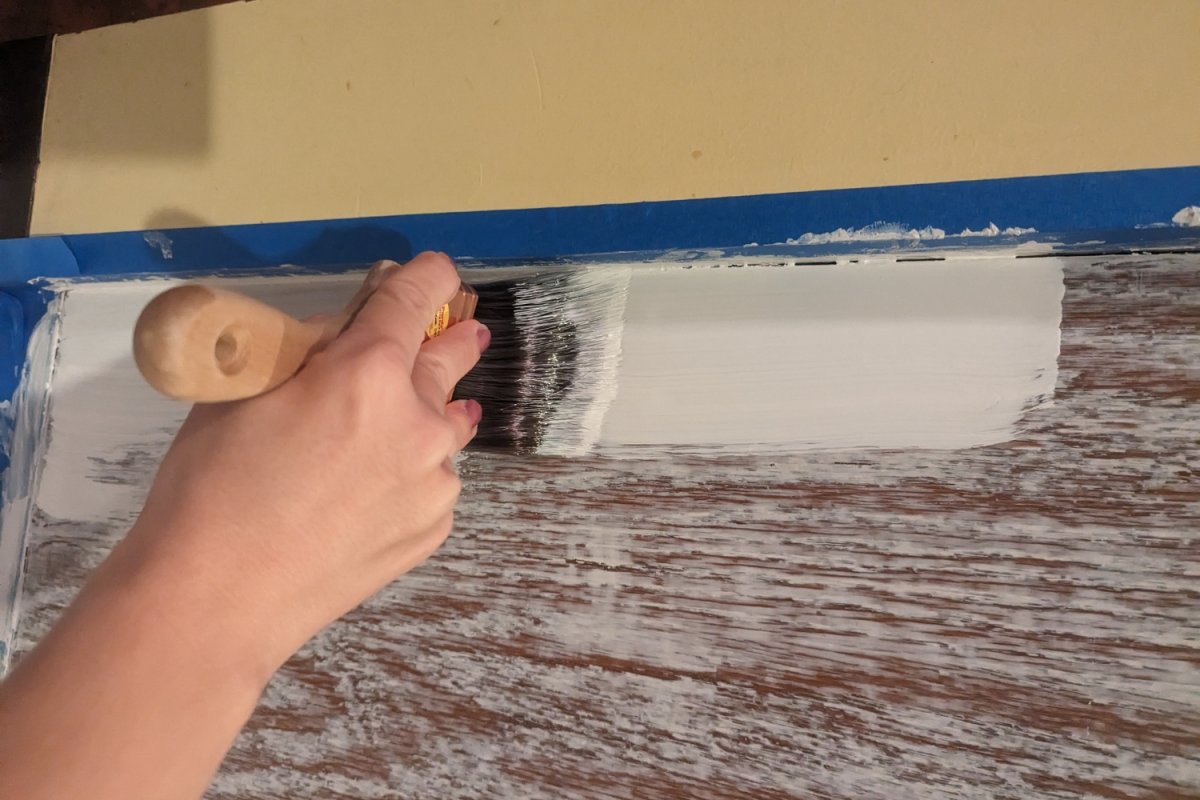
We may earn revenue from the products available on this page and participate in affiliate programs. Learn More ›
Few areas in the home make as big an impact on its aesthetic vibe as cabinets, whether they be in the kitchen or bathroom. Easily upgradable and customizable, cabinets can be given a whole new look without applying any advanced carpentry, and the reward for the amount of effort put in is almost always disproportionately beneficial. Although painting cabinets is a simple task, choosing the one tool that’s absolutely necessary—the paint brush—is a decision that shouldn’t be taken lightly.
However, finding the right high-quality cabinet paint brush for one’s specific needs can be a challenge. With so many similar options to choose from, separating what’s worth the money from what’s not can become overwhelming. Fortunately, we’ve taken care of this with extensive research and hands-on testing so buyers can quickly find the best cabinet paint brush and get to work. Our top choice, the Purdy XL Cub Angled Sash Paint Brush, features an angled shape for a neat finish and is wide and sturdy enough to paint your cabinets with ease.
- BEST OVERALL: Purdy XL Cub Angled Sash Paint Brush
- BEST BANG FOR THE BUCK: Wooster Brush Q3211-2 Shortcut Angle Sash Paint Brush
- BEST FOR SMALL AREAS: Wooster Brush Q3208-1 Softip Angle Sash Paint Brush
- BEST FOR LARGE AREAS: Purdy Nylox Swan Paint Brush
- BEST FOR NONPAINT FINISH: Minwax Polycrylic Wood Stain Brush
- BEST CABINET PAINT ROLLER: Work Tools International Whizz Purple Velour Roller
- BEST CABINET BRUSH SET: Pro Grade 5-Piece Paint Brush Set
- BEST ERGONOMIC BRUSH: Proform P2.5AS Pro-Ergo 70/30 Blend Paint Brush
- BEST MULTISURFACE BRUSH: Modern Art Supplies Chalk and Wax Oval Paint Brushes
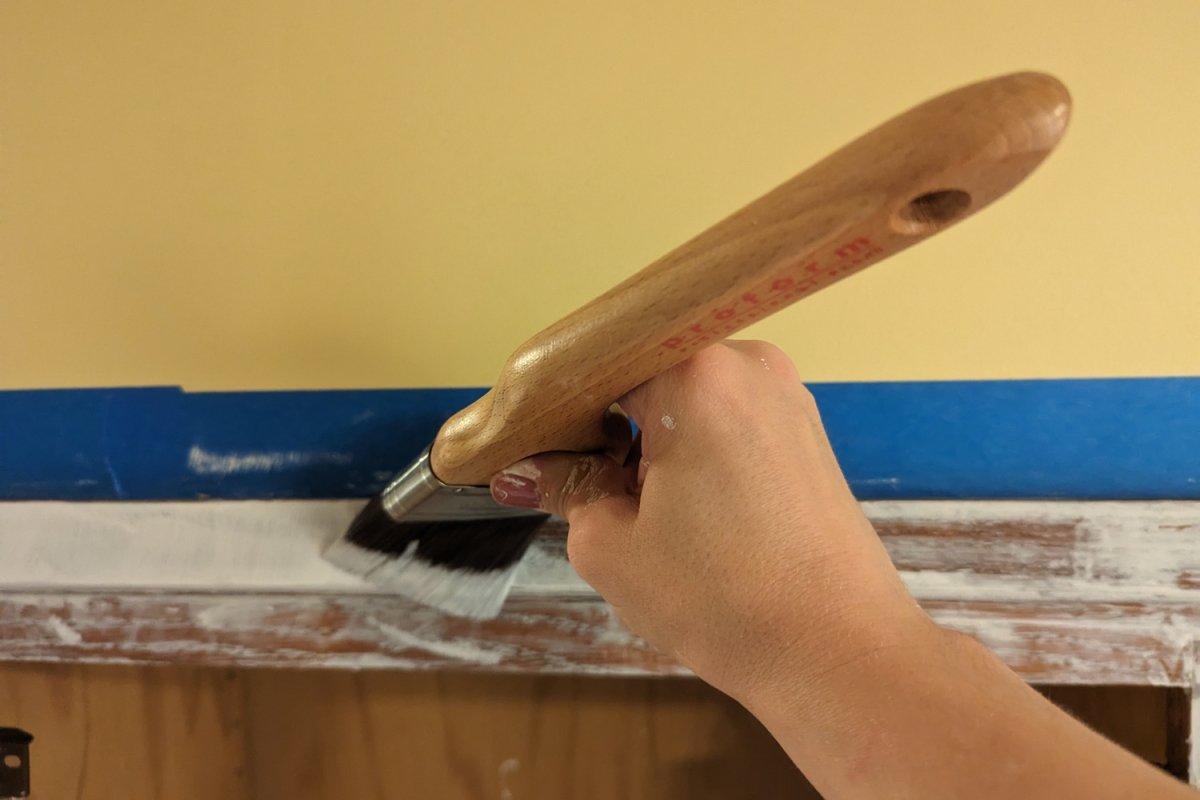
| Sash width | Firmness | Bristle type | |
| Purdy XL Cub Angled Sash Paint Brush | 2½ inches | Medium stiff | Synthetic nylon–polyester blend |
| Wooster Brush Q3211-2 Shortcut Angle Sash Paint Brush | 2 inches | Medium stiff | Synthetic nylon–polyester blend |
| Wooster Brush Q3208-1 Softip Angle Sash Paint Brush | 1 inch | Soft | Nylon and polyester |
| Purdy Nylox Swan Paint Brush | 4 inches | Soft | Nylon |
| Minwax Polycrylic Wood Stain Brush | 2 inches | Soft | Synthetic nylon–polyester blend |
| Work Tools International Whizz Purple Velour Roller | 4 inches | Smooth | Velour |
| Pro Grade 5-Piece Paint Brush Set | 1 to 2½ inches | Soft/medium | Solid synthetic round-tapered filament |
| Proform P2.5AS Pro-Ergo 70/30 Blend Paint Brush | 2½ inches | Medium stiff/stiff | 70/30 polybutylene terephthalate (PBT) blend |
| Modern Art Supplies Chalk and Wax Oval Paint Brushes | 1 to 2½ inches | Soft | Natural |
Our Top Picks
From cheap to expensive, soft to firm, angled to straight, these are the best cabinet paint brushes on the market. Each of our selected top picks has a thoroughly vetted list of pros and cons, results from our hands-on experience with the products, and/or top product specifications to keep in mind when choosing the best option for painting kitchen cabinets.
Best Overall
Purdy XL Cub Angled Sash Paint Brush
What We Like
- Angled shape creates clean lines and a streak-free finish upon application
- Width is good for both detail work and flat surfaces; worked well on the inside of a cabinet box upon testing
- The medium-stiff bristles are made to be easy to clean after use
- Made in the U.S. by an industry leader in reliability
What We Don’t Like
- Expensive compared to other cheap paint brushes on the market
- Some users have reported shedding after extended use
Product Specs
- Sash width: 2½ inches
- Firmness: Medium stiff
- Bristle type: Synthetic nylon–polyester blend
Often a single home can have a variety of cabinet styles, and the Purdy XL Cub is capable of handling almost every cabinet style imaginable. The bristles are made from patented Tynex nylon and Orel polyester, which are durable and maintainable. Like most polyester and nylon paint brushes, this option is great for all types of paint, as well as nonpaint finishes such as polyurethane.
The Purdy XL Cub comes in a smaller 2-inch width, but the 2½-inch brush is better for cabinets; painting cabinets often means covering a large surface area, and wider brushes are more efficient for that task. For a big cabinet refinishing or painting project coming up, shoppers can count on the Purdy XL Cub’s ergonomic handle to keep their hands comfortable hour after hour. The only downside with this option is that some customers have reported poor bristle quality or shedding after extended use.
What our tester says: Kathleen Corlett, editor in chief of Bob Vila, notes that “the Purdy XL Cub was my favorite brush for its substantial width and how well its sturdy nylon bristles held my water-based paint. It was only a half-inch wider than the 2-inch-wide Wooster, but I felt that each brush load helped me get through cutting in around a cabinet box more efficiently. It cleaned up well, too.”
Get the Purdy XL Cub paint brush for cabinets at Amazon, Lowe’s, or Ace Hardware.
Best Bang for the Buck
Wooster Brush Q3211-2 Shortcut Angle Sash Paint Brush
What We Like
- Provided excellent ease of use when painting in small, hard-to-reach areas around appliances or on trim
- The unique handle design is comfortable, precise, and highly maneuverable
- Easy to clean and maintain; did not shed after a few uses and cleanings
What We Don’t Like
- The short handle makes it easy to get hands dirty
Product Specs
- Sash width: 2 inches
- Firmness: Medium stiff
- Bristle type: Synthetic nylon–polyester blend
The Wooster Shortcut has a shortened handle, as the name implies, that fits neatly into the palm of the hand. The fit that the unique handle provides allows users to apply variable amounts of pressure with their fingers while exerting precise control over the paint brush’s movement with minimal wrist and hand motion. The small handle also makes this brush ideal for tight spaces, which is especially useful for painting cabinet interiors. The white China nylon–polyester blend is designed to leave a smooth, streak-free finish. Another great aspect of this brush is its compatibility with all latex- and oil-based paints and finishes.
What our tester says: Kathleen Corlett, editor in chief of Bob Vila, notes that “the Wooster Shortcut surprised me: It cost half of what our Best Overall did at the time of purchase but offered great value. Each brushstroke was slightly more narrow than the Purdy XL, and the bristles were a little less firm (even though they are also classified as “medium firm”), but the short handle and flexible handle also offered more control. Plus, I appreciated the short handle in tighter spaces (like when I was painting the cabinet exterior that wrapped around my refrigerator but I hadn’t pulled my fridge all the way out of its spot for the work). Best of all, I didn’t have any problems with bristles falling out, even after several rounds of cleaning.”
What our tester says: Glenda Taylor, Bob Vila product tester and writer, notes in The Best Paint Brushes for Trim that “we’ve used Wooster Shortcut brushes in the past, primarily for cutting in along walls in restricted spots. The stubby handle on the Shortcut is flexible and bends easily to either side, but it’s still sturdy enough to control the bristles and paint placement. Painting trim typically takes a light touch rather than excess pressure, so the handle didn’t bend much in our tests. You can get a good finish as the Wooster gives a better finish on trim boards rather than a brush that’s too long to control while painting trim.”
Get the Wooster Q3211-2 paint brush for cabinets at Amazon, Ace Hardware, or The Home Depot.
Best for Small Areas
Wooster Brush Q3208-1 Softip Angle Sash Paint Brush
What We Like
- Made with soft nylon and polyester bristles for smooth application and a streak-free finish
- Durable brass-plated ferrule and solid plastic handle are capable of withstanding multiple uses
- Made with an angled sash and chiseled trim for reaching into corners and tight spaces
What We Don’t Like
- The bristles may fray or fall out with heavy-duty or extended use
Product Specs
- Sash width: 1 inch
- Firmness: Soft
- Bristle type: Nylon and polyester
Small areas around or in cabinetry need a brush that provides a streak-free finish and soft bristles, making this option from Wooster an ideal choice. Made with nylon and polyester, this Wooster paint brush has soft brush tips for an even finish when used with most paints but works best with oil-based or latex paint.
The 1-inch-wide bristles on this brush are also made with a chisel trim and angled cut sash that reaches into curves and corners easily, making this option the best paint brush for edges or tight spaces. The handle is made of solid plastic, and all of the bristles are held together with a brass-plated steel ferrule for durability through many uses.
Get the Wooster Q3208-1 paint brush for cabinets at Amazon.
Best for Large Areas
Purdy Nylox Swan Paint Brush
What We Like
- Wide sash has good coverage when painting the interior or exterior of a cabinet box, cabinet door, or some trim
- The soft hardwood handle is comfortable to hold over extended periods of use
- Soft bristles reduce brush marks for a streak-free finish
What We Don’t Like
- Paint pickup is lacking considering the size of the brush
- Wide sash can be hard to maneuver in tight spaces
Product Specs
- Sash width: 4 inches
- Firmness: Soft
- Bristle type: Nylon
Nylox is one of Purdy’s top-tier paint-brush lines, and the Swan features the same 100 percent black nylon bristles that professionals swear by. For those after a super-smooth finish and who have a large space to cover, this brush can save time and effort. The soft bristles are designed to apply paint smoothly while minimizing the visibility of any leftover brushstrokes.
The brush pickup isn’t amazing, but that’s because if using less paint, it’s less likely to create brushstrokes, which is what this brush is made to avoid. Another great feature of the Purdy Nylox Swan is the smooth hardwood handle, which has a nice taper in the middle that makes it easy and comfortable to grip.
Get the Purdy Nylox Swan paint brush for cabinets at Amazon.
Best for Nonpaint Finish
Minwax Polycrylic Wood Stain Brush
What We Like
- Polyester bristles are ideal for water-based finishes; provides an even finish on most wood varieties
- Versatile construction; the 2-inch sash size is capable of painting large areas while being small enough to get into tight spots
- Affordable compared to other options we researched and tested
- Provides generous pick up and ease of use for its size
What We Don’t Like
- Incompatible with oil-based stains; should only be used with water-based products
Product Specs
- Sash width: 2 inches
- Firmness: Soft
- Bristle type: Synthetic nylon–polyester blend
Among woodworkers, there’s a good chance their cabinets aren’t painted. Many people want to keep the natural look of their wooden cabinets and let the grain flow speak for itself. If that’s the goal, users might want to opt for a nonpaint finish that’s clear or mildly tinted. However, as with painting, the brush choice still makes a big impact on the final product.
Minwax is a leader in the wood finish industry, and its brush is designed to be reliable, effective, and easy to maintain. The bristles are stiff enough to give users the precision they need to avoid creating high spots, which refers to the finish beginning to build in a certain area, as well as the flexibility to minimize brush marks. The bristles are purpose-built for latex-based products, so there’s no need to worry about them soaking up all of an expensive finish.
Though these brushes are incompatible with oil-based finishes, they are ideal for water-based finishes, which are becoming increasingly common and preferred by professionals because of the ease of application and durability of the end product.
Get the Minwax paint brush for cabinets at Amazon or Ace Hardware.
Best Cabinet Paint Roller
Work Tools International Whizz Purple Velour Roller
What We Like
- 4-inch wide roller can cover large surface areas quickly; suitable for cabinet doors and exteriors
- Provides an even finish with the help of the smooth velour roller material
- Budget-friendly price point compared to other options on this list
- Easy to maneuver design is comfortable to use while painting
What We Don’t Like
- Some shedding after the first few uses; may need to be rinsed before use to get rid of stray fibers
- Some users have reported that the roller function can be stiff or hard to use
- Replacement rollers aren’t easy to find at local hardware stores
Product Specs
- Roller width: 4 inches
- Surface feel: Smooth
- Roller material: Velour
Many painters prefer rollers because they’re easy to maintain and often make quicker work of painting than large paint brushes do. The main drawbacks of using rollers are that they’re hard to maneuver and usually suitable for wide planks only, like on cabinet doors and exteriors. However, the Whizz Velour solves both of those problems. With an appropriately sized handle of roughly 8 inches and a 4-inch roller width, this roller is both easy to maneuver and precise. Best of all, it still retains its superior speed and efficiency characteristics.
The Whizz Velour material is soft and results in smooth, even coverage. Also, with a bit of simple overlapping, the user can completely cover up any roller marks that remain after the first coat; however, this roller leaves very few to begin with.
Get the Work Tools International paint roller for cabinets at Amazon.
Best Cabinet Brush Set
Pro Grade 5-Piece Paint Brush Set
What We Like
- 5 different brushes to choose from; comes with 3 angled brushes and 2 flat brushes of varying sash brush widths
- Durable, easy-to-maintain bristle type; constructed with a synthetic filament blend
- Made with a solid wood handle and a stainless steel ferrule; the handle has an eyelet for hanging and draining
- Some of the best paint brushes for a smooth finish; provides even application and generous pickup with the help of the thin ends
What We Don’t Like
- Bristles may be too soft to achieve the sharpest possible edge in tight spaces and corners
Product Specs
- Sash width: 1 to 2½ inches
- Firmness: Soft/medium
- Bristle type: Solid synthetic round-tapered filament
This Pro Grade set proves that high-quality paint brushes don’t have to be expensive. Rather than trying to get one brush that does it all, the Pro Grade set tailors to those who prefer to match their tools to the project as closely as possible. The set includes two flat brushes and three angled brushes, all of different sizes, so users can tackle wide, flat surfaces as well as trim pieces of varying dimensions with ease. Another upside of these brushes is the solid synthetic round-tapered bristles.
These wood paint brushes are designed to pick up as much paint as possible by having thin bristles on the end, thereby saving the user time while also releasing paint as quickly as possible during cleanup, making these brushes easy to maintain. Each solid wood handle also has a convenient eyelet in the top so the brushes can be neatly hung and stored with the bristles facing down so any excess liquid drains out.
What our tester says: Glenda Taylor, Bob Vila writer and product, notes in our tested guide that “each Pro Grade trim paint brush performed well in our tests. They gave us excellent finish results when used with high-quality, self-smoothing paint. We checked the finished trim boards under strong light when they dried and saw very few brush strokes. The Pro Grade brushes cleaned up well. After soaking them, we washed them under a running faucet and removed virtually all traces of paint. We were impressed overall, especially considering the set’s affordability.”
Get the Pro Grade paint brushes for cabinets at Amazon or The Home Depot.
Best Ergonomic Brush
Proform P2.5AS Pro-Ergo 70/30 Blend Paint Brush
What We Like
- Professional-grade durability; made with 70/30 PBT blend bristles and beech wood
- Comfortable beaver tail handle design should not cause too much strain during extended use
- Slightly stiffer bristles offer precision in tight spaces, corners, or around appliances
What We Don’t Like
- Comparatively expensive; may not be ideal for some users’ preferences
- Small adjustments may need to be made when getting used to the unusual handle shape
Product Specs
- Sash width: 2½ inches
- Firmness: Medium stiff/stiff
- Bristle type: 70/30 polybutylene terephthalate (PBT) blend
The Proform Pro-Ergo paint brush is purpose-built for comfort and consistent precision during long painting sessions where hand fatigue and discomfort may become a concern. Even the most seasoned professional painters can’t avoid a slip in quality when they’re running low on energy, but this brush aims to delay energy loss by increasing comfort and efficiency in the process.
The hardwood beaver tail handle design has not only a natural contour but also a smooth depression that gently hugs one’s finger or thumb, giving the user acute control over the brush and the application of pressure. Ultimately, this increased control and comfort also result in a smoother finish and fewer brushstrokes, especially once the user gets the hang of using it. To top it all off, the 70/30 PBT blend bristles are incredibly durable and can withstand countless cleanings, even with harsh solvents.
What our tester says: Kathleen Corlett, editor in chief of Bob Vila, notes, “I also tried the Proform Pro-Ergo paint brush. Its unique grip features a groove for your thumb, which feels clever and very natural. The longer handle was not as convenient for some of the paintwork in tight positions, so it might not be my first choice for cabinets that turn corners and wrap around appliances. That said, I’ve already used it in another paint project to cut in around molding and was pleased with how comfortable it was to use throughout several hours of work.”
Get the Proform paint brush for cabinets at Amazon.
Best Multisurface Brush
Modern Art Supplies Chalk and Wax Oval Paint Brushes
What We Like
- Soft bristles minimize the chance of brushstrokes; compatible with metal, cloth, wood, and more
- The comfortable handle and leather loop make the brush easy to control
- Compatible with all types of paint and finish, including wax
What We Don’t Like
- Bristles begin to shed slightly after a few uses
Product Specs
- Sash width: 1 to 2½ inches
- Firmness: Soft
- Bristle type: Natural
This cabinet paint brush is unique in that although it’s relatively purpose-built, it’s quite versatile. Users can paint everything from upholstery and fabric to metal and wood with these brushes, and can even take their finishing skills to the next level by experimenting with less common finishes such as soap wax.
Most natural bristle brushes are soft and smooth, and the natural splits at the end of each fiber on these brushes help increase pickup and the smoothness of the final product. However, the natural bristles aren’t quite as durable as most synthetic blends; but if properly cared for, they can last just as long as even the best man-made alternatives.
Get the Modern Art Supplies paint brushes for cabinets at Amazon.
Jump to Our Top Picks
How We Chose the Best Paint Brushes for Cabinets
The best brush for painting cabinets depends on a variety of factors. Each product on our list made the cut after thorough research, hands-on testing, and an examination of what verified customers had to say about their experience with them. We made sure to cast a wide net at the start by considering cabinet paint brushes at a variety of price points from several manufacturers.
In addition to each manufacturer’s reputation and the overall quality of their products, we researched or hands-on tested products in terms of their firmness, shape, angle, and size. Once we knew which of the DIY or professional painting brushes excelled in each area, we measured their durability as well as their price against their functionality to get a sense of their relative value. The cabinet paint brushes that we selected are all top-tier in terms of value.
What to Consider When Choosing Paint Brushes for Cabinets
Choosing a paint brush for cabinets can be a daunting task. When researching and selecting our final recommendations, we paid particular attention to the following considerations to ensure that they were ideal for this bathroom, laundry room, or kitchen painting task.
Type
Cabinet paint brushes are made out of a variety of materials and come in all shapes and sizes. Compounding the difficulty presented by the sheer variety of cabinet paint brushes is the fact that many similar products have contradictory and overlapping descriptions. When it comes to finding the right type of brush, there are five main categories:
Natural Bristle
Natural bristle brushes are made from animal hair, usually horses, hogs, or badgers, or a combination of the three, and tend to be more expensive than their synthetic counterparts. Ironically, although we dread split ends in our own hair, the fact that natural hairs split is one of the main selling points for natural brushes; the split allows them to hold more paint and results in a smoother application. However, natural bristles are incompatible with water-based paint because the splits will absorb too much water, which ruins the paint. If shoppers are refinishing their cabinets with stain or a similar alternative, such as Danish or linseed oil instead of paint, natural bristles are the way to go.
Synthetic Bristle
Synthetic bristles are usually cheaper, although high-end synthetic brushes can cost just as much, if not more, than their natural counterparts. Although synthetic bristles aren’t as absorbent as natural bristles, they’re more versatile, especially considering that they work with both water- and oil-based finishes. Synthetic bristles are usually made from nylon or polyester, although many large manufacturers have developed unique bristle materials. Top-quality cabinet paint brushes will often have blended synthetic bristles that combine nylon with polyester, for example.
Hybrid
Hybrid bristles combine the best of natural and synthetic bristles in a single sash, which is the technical term for the bristle group. Hybrid brushes offer the longevity and superior paint pickup associated with natural bristles, as well as the favorable characteristics from synthetic bristles, such as minimized brushstrokes. The natural bristles tend to be shorter than the synthetic bristles in hybrid brushes, so users have some control in certain situations. Expect hybrid brushes to be more expensive than synthetic brushes, although they’re cheaper than fully natural brushes.
Foam
Foam brushes are absorbent and provide a smooth finish. They are designed to be disposed of after a single use, although users might be able to get two coats out of a single foam brush if they’re lucky. Foam brushes have durable, defined edges that result in precise lines. However, foam brushes tend to have straight-stick handles that aren’t comfortable, especially when they’re used for longer periods.
Roller
Rollers come in a variety of materials, from fluffy cotton to firm foam as well as an array of widths. Rollers are great for covering large, flat areas in a small amount of time. However, rollers aren’t great for cutting in or for tight areas. Also, contrary to what many think, rollers can leave marks just like brushes do, so painters still need to use a careful hand in the final coats.
Firmness
Firm brushes are easier to control and more precise, while softer brushes provide a smoother finish because they minimize the visibility of brushstrokes. Softer brushes are also great for covering large spaces, and they don’t have as much resistance in the bristles and are more comfortable for extended use. Many home painters, DIYers and professionals alike, opt for a medium-stiff brush that keeps its shape and offers the precision of a hard brush without leaving deep brush marks.
Size and Angle
Good paint brushes come in all shapes and sizes. Some are round while others are flat, and there are also thick and thin varieties. But in terms of cabinet painting, thankfully users have to consider only a few variations. Cabinet paint brushes tend to have a flat sash with a chiseled edge that helps create clean lines. However, some cabinet brushes are wide and have a thick, flat edge that holds a lot of paint; these brushes, known as square brushes, are best for painting intricate details with the same color.
Alternatively, there are brushes with angled edges, which are great for cutting into adjoining surfaces that will be contrasting colors. Angled brushes are also ideal for narrow areas. In terms of width, cabinet brushes usually range between 3 and 6 inches. Narrower brushes are easier to maneuver and more precise than their wider counterparts, although they don’t hold as much paint and aren’t nearly as efficient for large projects.
Comfort
Comfort is key for cabinet paint brushes, and there’s more to it than meets the eye. The handle is the first thing to take into consideration; those who regularly get stiff palms from long painting sessions should take a look at brushes with ergonomic or cushioned handles.
Small handles are easy to grip but may move around in one’s hand, while larger handles have the opposite issue. Also, don’t disregard the stiffness of the bristles. Stiffer bristles require the user to apply more pressure, which may cause painters’ hands to fatigue quickly.
Tips for Using Paint Brushes for Cabinets
Painting cabinets, whether they are in a bathroom or kitchen, isn’t as easy as it’s cracked up to be. Between the processes involved with doing any DIY painting and the specific techniques needed to achieve a show-stopping finish, getting everything right can be a challenge. However, there are a few quick tips that, if properly followed, can take one’s painting game to the next level.
- Approach corners and edges from below and arc upwards toward the edge with the angle of the brush to get the cleanest lines possible.
- Use the appropriate amount of paint for the brush; we recommend tapping it against the side of the paint can or tray at least twice because excess paint causes visible brushstrokes.
- Paint in the direction of the wood grain, if applicable, on the finish strokes, and always paint back and forth across the same plane; don’t move horizontally and then vertically with a brush.
Tips for Painting Cabinets
Cabinetry can make or break a kitchen space, and painting it can be a scary job for first timers. Here are a few quick tips to keep in mind when taking on the task of painting cabinets yourself.
- Make sure to remove all hardware, including internal hardware, before painting.
- Clean each surface that’s going to be painted with a grease-cutting solution, especially if you’re refinishing your kitchen cabinets where spills and stains abound.
- Use painter’s tape to number each cabinet face on the side that’s not currently being painted to keep track of where they go.
- Sand between each coat once it’s completely dry to remove brushmarks and get the smoothest possible finish.
- After sanding, let the dust settle before vacuuming the surface of what was just sanded as well as the entire room you’ll be painting to reduce the amount of dust in the air.
FAQs
Any professional will tell you that one of the best predictors of a high-quality end product is how well the painter uses their “know-how” to get the job done. Painting cabinets may look simple on the surface, but the reality is that achieving a stunning finish, whether it be high gloss, multicolor, or matte, requires a certain amount of planning and patience. Cabinet painting is all about finding ways to enhance workflow efficiency without compromising the end product. Check out the FAQs below to fast-track your understanding of how to get the job done well.
Softer bristles result in smoother finishes, although softer isn’t always better. The best materials for a smooth finish are typically nylon, polyester, or white China, all of which provide the streak-free application that most users look for.
All cabinets should get at least two coats of paint—and likely two coats of primer. If you’re painting high-traffic cabinets, you may want to consider three coats of paint. Ensure that the paint is distributed evenly throughout the application process, or it could dry looking patchy.
If this is the first time the cabinets are being finished, failing to sand before painting will result in a rougher end finish. However, not all paint refinishing jobs require sanding. Sand anything that is damaged, dented, chipped, or rough.
For wood cabinets, brush painting is the most common DIY method because it’s more intuitive, requires less materials, and is overall much easier. In addition to being cheaper and easier to set up and clean up, the best paint brushes give painters more control over coat thickness and ultimately allow them to create a longer-lasting finish with thick coats. However, brush painting often leaves marks and is quite time-consuming. Spray-painting offers smoother coverage and quicker application but requires additional tools, which have their own learning curve.
To get started, you’re going to need a few rolls of high-quality painter’s tape, 40- to 50-grit sandpaper to remove any larger imperfections or dents, and 120- to 220-grit sandpaper for smoothing in between coats. We also recommend keeping paint thinner or remover close by as well as some drop cloths and paper towels in case of emergencies.
